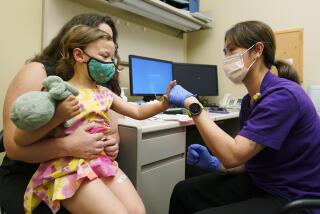‘90s Family : When Kids Care for Kids, They Need Proper Training
- Share via
A paradox of modern family life is that many parents, desperate for a night out, routinely hand over their most precious possessions to people whose most predictable trait is unpredictability.
The fact is, kids 10 to 14 are the nation’s de facto baby-sitters at an age when some cities deem them too young to be left alone unsupervised. They are trusted, sometimes cajoled or even tricked into caring for mixed groups of needy infants, defiant toddlers and rowdy preschoolers when they themselves are testing the limits. It is widely assumed they know what to do in emergencies, even though many families don’t provide hands-on experience at home.
Accidents happen.
That we don’t hear of a great number of tragedies means only that “Mother Luck is shining over us all,” said Ruby Takanishi, executive director of the Carnegie Council on Adolescent Development in Washington.
She wasn’t shining on a spring day in 1980 when Dr. Patricia Keener, an Indianapolis pediatrician, was going to work with a friend. As they entered the hospital, the friend was asked to call home on a sitter problem and Keener was paged to go to the emergency room. “Her child was brought in. She was dying on the way to the hospital. It was not clear if she choked on toast or a piece of blanket,” Keener said.
The adult sitter had not known the Heimlich maneuver, nor how to relieve an airway obstruction. By the time she called for help, it was too late for Keener to resuscitate her friend’s 18-month-old girl.
Keener said the only way she could live with that horror was to start training sitters as early as possible. Last year, her “Safe Sitter” program taught 20,000 11- to 13-year-olds through hospitals nationwide.
In small classes, students learn lifesaving techniques, accident prevention, child development, the responsibilities and ethics of safe baby-sitting, age-appropriate entertainment and benign discipline. They are taught to prevent accidents by declining to bathe children, supervise swimming or cook food.
(Call [800] 255-4089 for the nearest program.)
What still makes some child development specialists uneasy is that wide, unpredictable mood swings are the normal state of affairs for young adolescents.
“Developmentally, some 10- to 13-year-olds are capable of doing a good job, and some, perhaps the majority, are not,” said Peter Scales, a specialist on adolescents with the Search Institute, a Minneapolis research organization on children and youth. Kids that age are better off in adult supervised activities, not exploited as hourly wage earners, he said.
But experts agree that even squirrelly adolescents are not squirrelly all the time and that their unpredictability can also work in parents’ favor. Given responsibility, training and attention, many youngsters do live up to the trust placed in them. Several Safe Sitter graduates have been honored for saving children’s lives, Keener said. One graduate of the program, who took the class in 1982, saved the life of her own child 10 years later when her baby choked on a coin.
Adolescent children can grow up in the process too. Some have overcome fears of being alone by focusing on their own role as protector.
Parent-employers can help by hiring carefully to make sure the sitter can handle the ages and number of children. Sitters can start with a tryout while the parent is still in the house. Parents should clearly explain all rules, leave emergency numbers, and eliminate surprises such as extra children, extra duties and extra hours. They should also firmly explain the transfer of authority to head off discipline problems, especially with siblings. They should pay on the spot in cash.
When small mistakes are made, parents should also use the opportunity to teach the sitter the right way. It’s one way this generation can learn not only to care for other people’s children, but also get a head start on preparing for parenthood.
More to Read
Sign up for Essential California
The most important California stories and recommendations in your inbox every morning.
You may occasionally receive promotional content from the Los Angeles Times.













